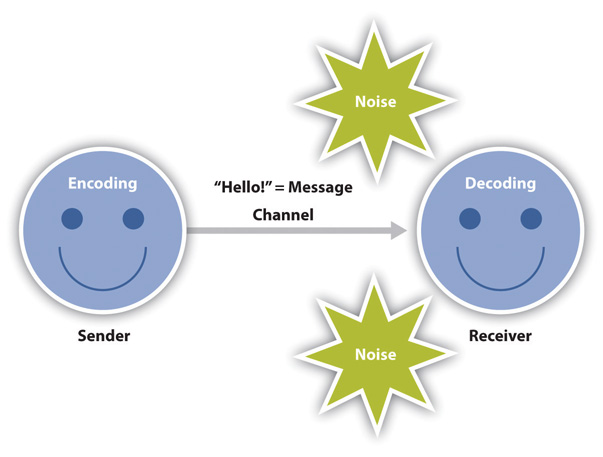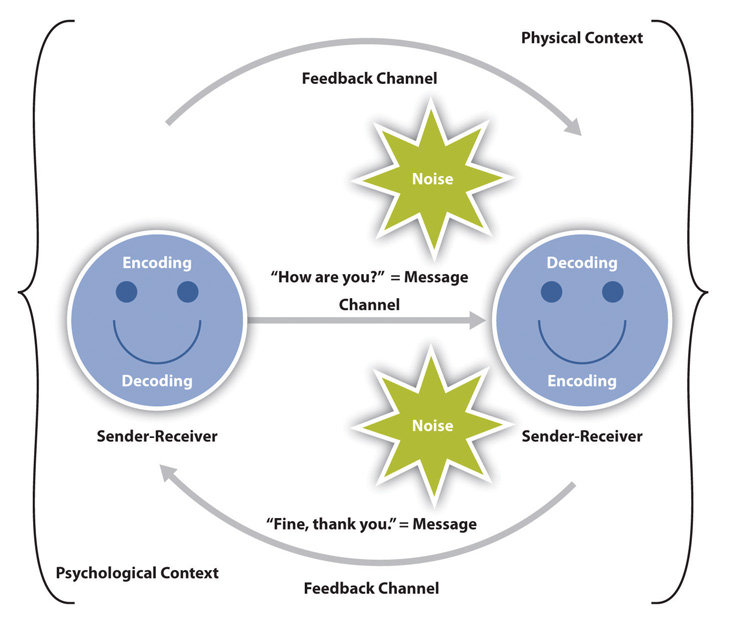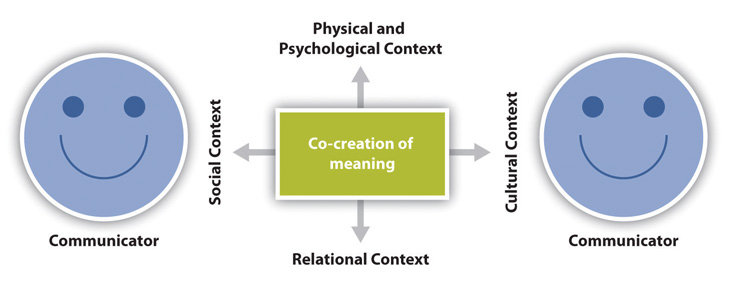3 How Communication Works: Process and Key Components
Venecia Williams; Nia Sonja; and Verna Johnson
At a basic level, human communication involves two key steps: encoding and decoding.
Encoding happens when a person creates and sends a message. This person is called the encoder. To communicate clearly, the encoder must think about who their audience is and how that audience will understand the message. Good communicators adjust their message so that the audience receives it in the intended way.
Encoding means turning your thoughts into words or other forms of communication. You might send your message through a medium like a phone call, email, text message, or face-to-face conversation. The amount of planning involved in encoding can vary depending on the situation. For example, you might think carefully before writing a formal email, but less so when sending a quick text to a friend.
The encoder also needs to consider anything that could prevent the message from being understood. These are called noise or barriers to communication. Examples of noise include other people talking nearby, confusing wording, technical problems, or even stress or tiredness that distracts the listener.
Once the message is sent, the audience receives and decodes it. Decoding means interpreting the message and turning it back into thoughts.
For example, imagine feeling hungry and saying to your roommate, “I’m hungry. Do you want to get pizza tonight?” You are the encoder, and your message is sent through spoken language. Your roommate hears and decodes your message—they turn your words into thoughts and decide what you mean.
Video 1.1: The Communication Process
When we communicate, we don’t always speak out loud. We have different ways—or channels—to send messages. A channel is how a message travels from the sender to the receiver. Messages can go through any of the five senses: sight, hearing, touch, taste, or smell. However, most communication happens through sight (what we see) and sound (what we hear).
For example, if your roommate plays video games with headphones on, they might not hear you. You may need to wave your hand (visual channel) to get their attention before speaking (auditory channel).
Linear Model
The linear model of communication, shown in Figure 1.2, describes communication as a one-way process. In this model, a sender creates and sends a message to a receiver, who may or may not respond. The process begins with the sender encoding a message and choosing a channel to transmit it. The receiver then decodes the message. There is no expectation of feedback, and the receiver is seen more as a passive target than an active participant.
This model was influenced by early communication systems like the telegraph and radio (Shannon & Weaver, 1949). For example, imagine a radio announcer speaking in a studio. The announcer (the sender) creates a message and sends it out through a radio tower (the channel). If you’re listening in your car, your radio antenna and speakers receive and play the message. The announcer does not know whether you heard or understood the message—they just send it and hope the technology works.
While the linear model helps us understand how messages are sent, it does not account for the role of feedback or the possibility of misunderstandings. It is a useful starting point, but real-life communication is usually more interactive.

Transmission Model
The transmission model, shown in Figure 1.3, explains communication as a one-way process. In this model, the sender creates and sends a message to the receiver. The receiver is like a target—they either get the message or don’t.
For example, imagine a radio announcer sending a message to you in your car. The announcer (sender) speaks into a microphone. That sound travels through radio waves (the channel) and reaches your car radio. You (the receiver) hear the message through your speakers. The announcer doesn’t know if you heard it or understood it. But the message probably reached you if the radio is working and there’s no static.

Interaction Model
The interaction model sees communication as a two-way process. Here, people take turns being the sender and the receiver. This model adds the idea of feedback. Feedback is a response to a message. It can be verbal or nonverbal.
For example, your teacher may respond to your question during class. Or if your roommate asks where the remote is, you might just point to the couch. Both are types of feedback.
This model also includes context—the physical and emotional setting around the conversation. For example, if you’re stressed or tired, your reaction may be different than if you’re relaxed.

Transaction Model
The transaction model, shown in Figure 1.4, shows that communication is ongoing and happens in both directions at the same time. In this model, people are called communicators instead of senders and receivers. That’s because both people send and receive messages at the same time.
For example, if you’re meeting a new friend, you may talk about your hobbies while noticing how they react through facial expressions or body language. You’re speaking (sending a message) and noticing their reactions (receiving feedback) at the same time.
This model also says communication helps us create social relationships, shape who we are, and build communities. It’s not just about passing information—it’s about building meaning together.

8 Essential Components of Communication
Communication has eight key parts that work together:
-
Source: The source is the person who starts the message. They think of the message, choose the right words, and send it. The source also watches how the audience reacts and may change the message if needed.
-
Message: The message is the meaning or idea the source wants to share. It can be spoken or written, including body language, tone, grammar, and structure.
-
Channel: The channel is the way the message travels. Spoken channels include face-to-face talk, phone calls, or voice messages. Written channels include letters, emails, texts, and social media.
-
Receiver: The receiver gets the message. They interpret the words, tone, and gestures. Sometimes, they understand what the sender meant, and sometimes, they do not.
-
Feedback: Feedback is the receiver’s response. It can be words, gestures, or even silence. Feedback helps the sender know if the message was understood correctly.
-
Environment: The environment is everything around communication, like the physical space, the people, the noise, or even your mood. These things can affect how messages are sent and received.
-
Context: Context is the situation or setting. For example, a job interview has a formal context. This affects how people dress, speak, and behave.
-
Interference: Interference (or noise) is anything that gets in the way of the message. It could be loud sounds, bad handwriting, or feeling tired or distracted. Interference makes it harder to send or understand the message clearly.
Attribution
This section was adapted from Chapter 1.2 “The Communication Process” in Fundamentals of Business Communication Revised (2022) and is used under a Creative Commons Attribution-ShareAlike 4.0 International license. This section contains material taken from Chapter 1.2 “The communication process” in Communication in the real world: An introduction to communication studies and is used under a CC-BY-NC-SA 4.0 International license.
Formulating a message to send.
Interpreting a message received.
One way communication sender creates and sends message to receiver. The receiver may or may not get message.
Two way communication here the sender and receiver.

